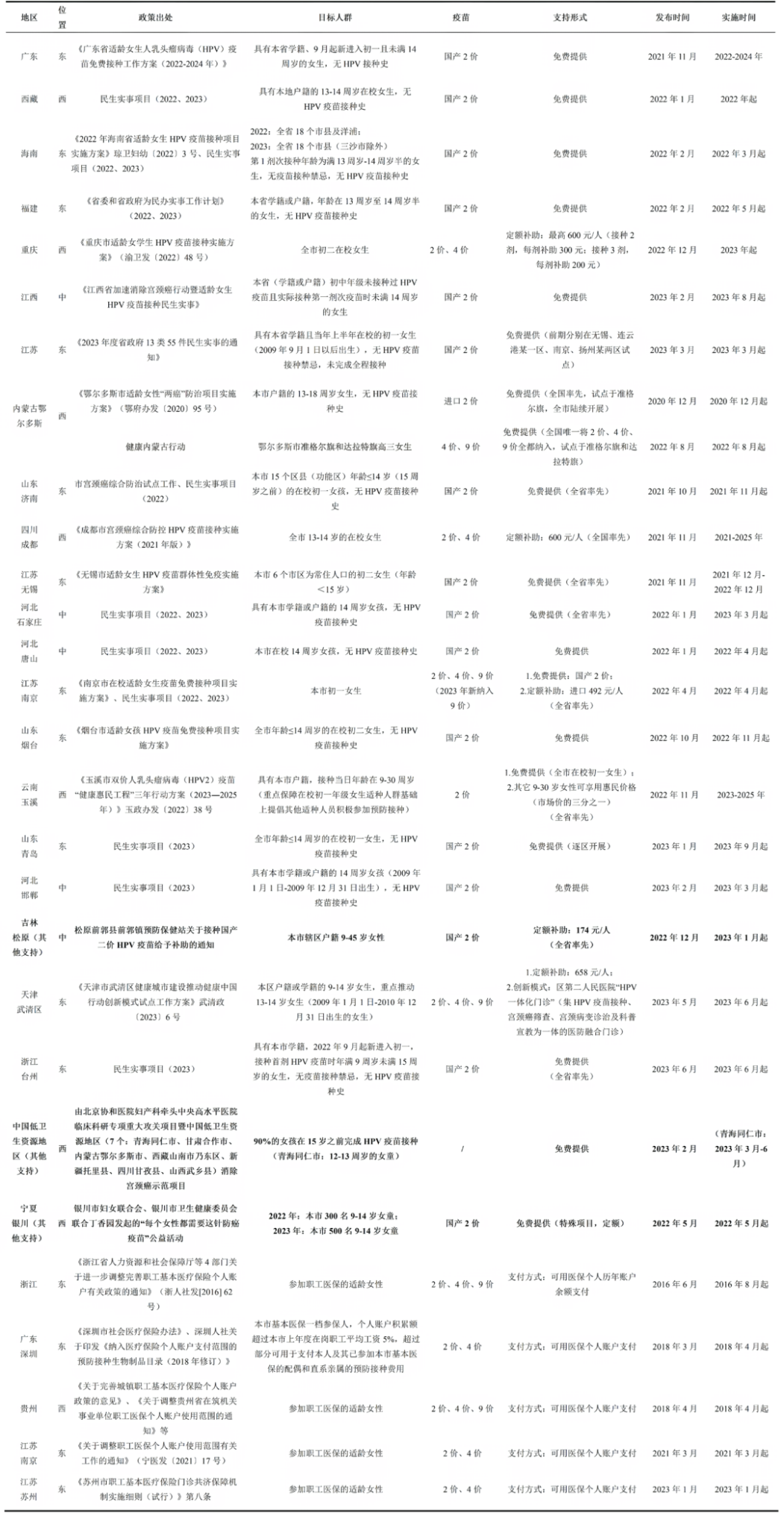Policy Updates
01
HPV Vaccine to Be Included in the National Immunization Program Within This Year
On the morning of September 11, the State Council Information Office held a press conference under the series “Achieving High-Quality Completion of the 14th Five-Year Plan,” introducing the achievements and progress in the health sectorduring this period. Shen Hongbing, Deputy Director of the National Health Commission and Director of the National Administration of Disease Prevention and Control , stated that the National Health Commission has optimized and adjusted the immunization schedule for the DTP vaccine and carried out supplementary polio vaccination, and this year will launch nationwide free HPV vaccination services for school-age girls. Furthermore, the HPV vaccine will be included into the National Immunization Program.
Source: CCTV News
02
Canada’s National Advisory Committee on Immunization Issues Recommendations on RSV Vaccination for Older Adults
The National Advisory Committee on Immunization (NACI) of Canada has recently released a statement recommending vaccination against respiratory syncytial virus (RSV) for adults aged 75 and above, particularly those with chronic underlying conditions who are at heightened risk of severe RSV infection. NACI additionally recommended that vaccination be prioritized for adults aged 60 and older residing in nursing homes or other long-term care facilities. For adults aged 50 to 74, NACI suggested that vaccination decisions may be made on an individual basis, depending on personal health status and risk assessment, in consultation with a healthcare provider.
https://doi.org/10.14745/ccdr.v51i08a01
Journal Article Recommendation
01
The impact of human papillomavirus (HPV) vaccination on the risk of adverse obstetric outcomes: a data linkage study
This article, published in the European Journal of Obstetrics & Gynecology and Reproductive Biology, aimed to evaluate the potential impact of HPV vaccination on adverse pregnancy outcomes in women. The study utilized routinely collected medical data from the Aberdeen region of the United Kingdom, linking pregnancy outcomes, HPV vaccination records, colposcopy findings, histological diagnoses, and subsequent cervical treatment information for 9,200 women (covering 11,174 spontaneous deliveries) between 2006 and 2020 to construct a retrospective cohort. The exposure factor was HPV vaccination, while the primary outcomes included spontaneous preterm birth (sPTB), low birth weight (LBW), and preterm premature rupture of membranes (PPROM). Associations between HPV vaccination and adverse outcomes were analyzed using generalized estimating equation (GEE) models.
The results showed no significant difference in the risk of spontaneous preterm birth between vaccinated and unvaccinated groups (adjusted odds ratio [aOR] = 1.00, 95% CI: 0.82–1.22, p = 0.27). However, risks for other adverse outcomes were significantly lower among vaccinated women. Specifically, the incidence of PPROM was markedly reduced [aOR = 0.52 (95% CI: 0.30–0.89), p = 0.03]; the risk of term premature rupture of membranes (PROM) was also lower [aOR = 0.25 (95% CI: 0.17–0.36), p < 0.01]. In addition, vaccinated women showed significantly reduced risks of preeclampsia [aOR = 0.38 (95% CI: 0.28–0.51)] and antepartum hemorrhage (APH) [aOR = 0.71 (95% CI: 0.59–0.85), p < 0.01].
The study concluded that although no association was observed between HPV vaccination and spontaneous preterm birth, vaccination may significantly reduce the risk of other adverse pregnancy outcomes, including PPROM, PROM, preeclampsia, and APH. These findings provide new scientific evidence supporting the safety of HPV vaccination in pregnancy.
https://doi.org/10.1016/j.ejogrb.2025.114678
02
Influenza vaccination hesitancy and decision between parental and grandparental caregivers of preschoolers: a comparative study
This article, published in Vaccine, aimed to systematically compare differences in influenza vaccination hesitancy (IVH) and vaccination decision-making between parents and grandparent caregivers of preschool-aged children in China, and to explore the potential role of grandparents in improving pediatric vaccination uptake. The study was conducted in 2024 across five Chinese cities, recruiting primary household caregivers of preschool children. Using propensity score matching (1:3), 225 grandparent caregivers were matched with 675 parents. A self-developed IVH scale and the Vaccine Hesitancy Determinants Matrix were employed to analyze key factors shaping vaccination attitudes and decisions in the two groups.
The results showed that the IVH score was significantly higher among parents (median 32, IQR: 28–36) compared with grandparents (median 30, IQR: 25–33) (p < 0.001), indicating that grandparents held more positive attitudes toward influenza vaccination. Mandatory vaccination policies had a favorable impact on both groups’ attitudes (parents: β = −1.60, p = 0.016; grandparents: β = −1.79, p = 0.044). Among vaccine-specific factors, adequate vaccine supply emerged as a common facilitator (parents: β = −3.28, p < 0.001; grandparents: β = −2.60, p = 0.014). Interaction analysis revealed that mandatory policies had a stronger effect on parents (β = 2.18, p < 0.001), while previous vaccination experience (β = −2.03, p = 0.024) and perceived benefits of vaccination (β = −1.15, p = 0.034) exerted greater influence on grandparents. For grandparents caring for children aged three years or younger, social media exposure (β = 6.14, p = 0.019) and heightened influenza risk perception (β = 4.52, p = 0.009) significantly increased their hesitancy levels. A Sankey diagram further demonstrated that although grandparents expressed more positive attitudes, their hesitancy levels were not always fully aligned with actual vaccination decisions, suggesting the involvement of additional influencing factors.
The study concluded that grandparents demonstrated more favorable attitudes and stronger willingness toward influenza vaccination for both themselves and their grandchildren. Public health practice should therefore recognize and engage grandparents as key stakeholders in pediatric vaccination decision-making, thereby helping to reduce inequities in vaccine accessibility and uptake among children.
https://doi.org/10.1016/j.vaccine.2025.127696
03
Comprehensive assessment of the impact of universal rotavirus vaccination program on the burden of diarrheal disease in children after 10 years of implementation in Argentina
This article, published in Vaccine, aimed to systematically evaluate the long-term impact of Argentina’s introduction of the monovalent rotavirus vaccine into the National Immunization Program (NIP) in 2015—administered as a two-dose schedule at 2 and 4 months of age—on diarrheal disease burden among children under five, and to assess the potential disruption caused by the COVID-19 pandemic. A mixed ecological time-trend analysis was conducted using national, regional surveillance, and health information system data. Four time periods were compared: pre-vaccine introduction (2010–2014), post-introduction but pre-pandemic (2016–2019), during the COVID-19 pandemic (2020–2021), and post-pandemic (2022–2024). Six key indicators were assessed: outpatient visits for acute diarrhea, diarrhea-related hospitalizations, diarrhea-related mortality, infant intussusception hospitalizations, laboratory-confirmed rotavirus cases, and vaccine coverage rates.
The results showed that, compared with the pre-vaccine period, the incidence of acute diarrhea decreased by 59.6%, hospitalizations by 47.6%, and diarrhea-related mortality by 59.7%. Rotavirus positivity declined by 55.2%, with the most pronounced reductions observed in infants under one year of age. Although some indicators slightly rebounded in the post-pandemic period, all remained below baseline levels. Nationwide, infant intussusception hospitalization rates declined by more than 30%, with no region exceeding pre-vaccine levels. Despite a temporary decline in vaccine coverage during the pandemic and incomplete recovery afterward, coverage rates overall remained significantly higher than baseline. Most indicators also varied significantly across age groups and time periods, highlighting infants as the most vulnerable group for severe outcomes.
The study concluded that the widespread introduction of rotavirus vaccination in Argentina substantially reduced the burden of diarrhea-related diseases in children, with stable and sustained effects and a favorable safety profile. It recommended continued efforts to increase coverage, strengthen interregional coordination, and enhance surveillance capacity to consolidate achievements and address future challenges.
https://doi.org/10.1016/j.vaccine.2025.127681
04
The Immunization Agenda 2030 Strategy to reach zero-dose children in low-income and middle-income countries: a scoping review
This article, published in BMJ Global Health, reviewed research progress on children in low- and middle-income countries (LMICs) who have received no routine vaccinations (“zero-dose,” ZD) since the adoption of the Immunization Agenda 2030 (IA2030) by the World Health Assembly in 2020. Following the PRISMA-ScR methodology, the study team systematically searched six databases, including MEDLINE (Ovid), for peer-reviewed quantitative studies published between January 2020 and January 2024. A total of 82 articles were included, covering prevalence, spatial distribution, vaccination barriers, and multidimensional deprivation among ZD children.
Among the included studies, 73 focused on the prevalence or distribution of ZD children, 24 investigated specific barriers within immunization services, and 44 analyzed multidimensional deprivation faced by ZD children, their families, and communities, with substantial contextual variations. The most frequently reported vaccination barriers were related to vaccination willingness (n = 20), followed by accessibility of community services (n = 10). In terms of deprivation, the key dimensions included limited access to health services—such as inadequate use of maternal and child health care (n = 22)—and broader developmental factors, such as low socioeconomic status (n = 29) and low maternal education or literacy levels (n = 28).
Notably, the review found no studies evaluating the effectiveness of interventions delivered through routine immunization services to reach ZD children, highlighting a major evidence gap. Although both IA2030 and Gavi have prioritized reducing the number of ZD children as a core goal, systematic evaluations of related interventions remain scarce. The authors emphasized that future research should focus on assessing the implementation and impact of concrete intervention strategies and advocate for context-specific, integrated approaches that address multiple deprivation factors simultaneously, ensuring that no child is left behind.
https://doi.org/10.1136/bmjgh-2024-018293
Content Editor: Tianyi Deng
Page Editor: Ruitong Li





